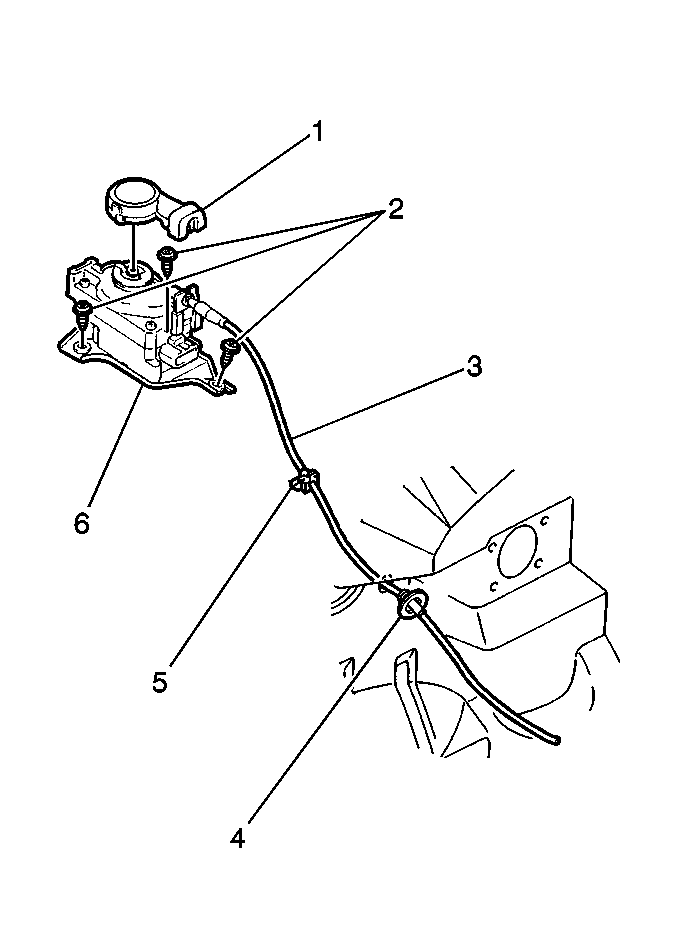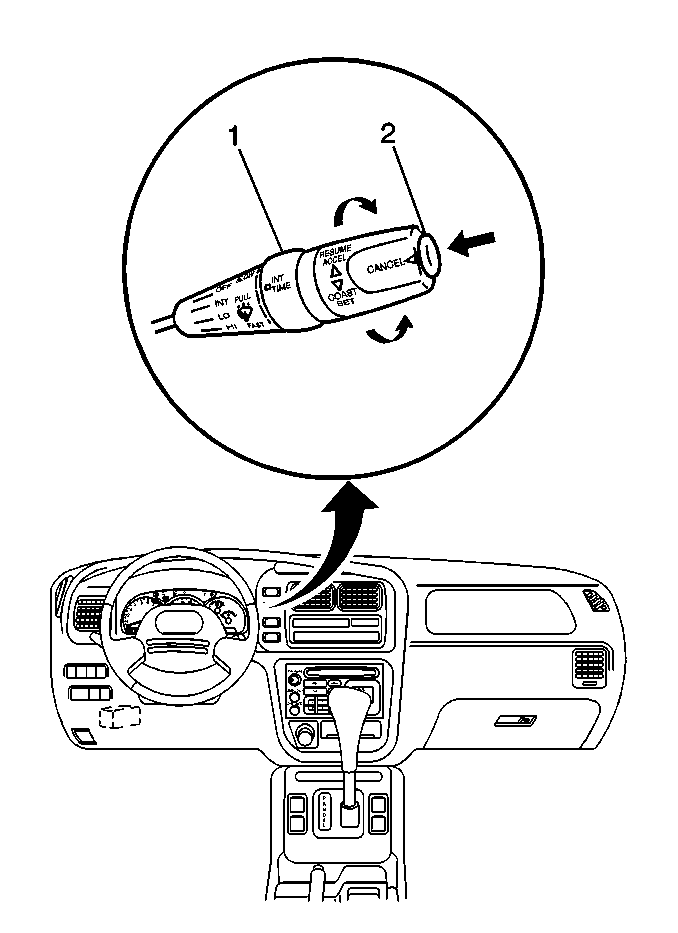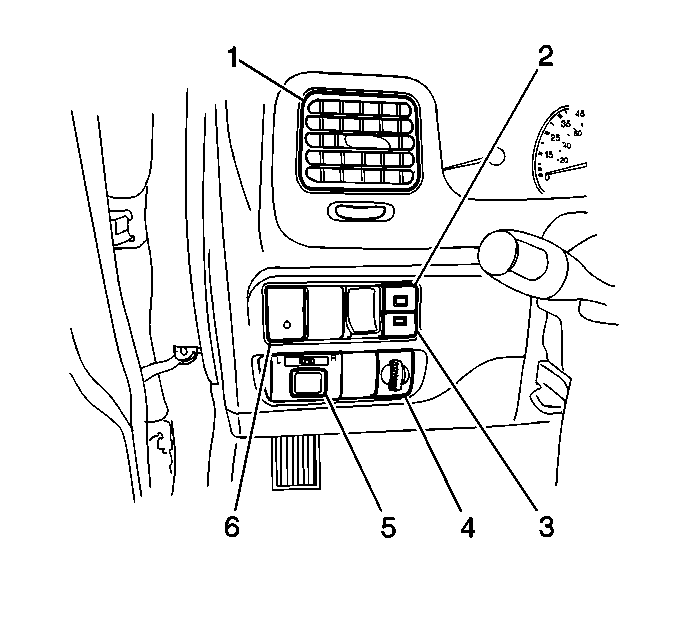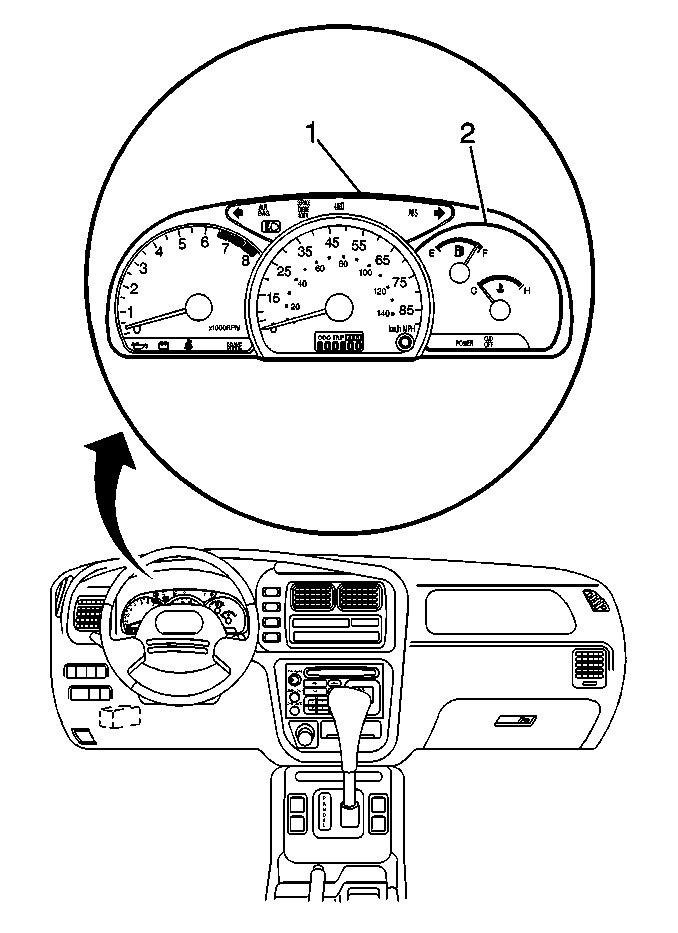Caution: Do not use the cruise control on slippery roads, steeply graded roads,
or in heavy traffic of heavy or varying volume. Failure to follow these CAUTIONS
could possibly cause you to loose control of the vehicle and result in damage
to the vehicle and personal injury.
Cruise control is a speed control system that maintains
a desired vehicle speed under normal driving conditions. The cruise control
allows the driver to maintain a constant speed of 25 mph (40 km/h)
or higher without depressing the accelerator. Any steep grades up or down
may cause variations in the selected speeds. The cruise control system performs
the following functions:
The cruise control system consists mainly of the following components:

| • | The cruise control servo assembly (6) |
| • | The cruise control release and clutch pedal position (CPP) switch
(manual transmission only) |

| • | The cruise control mode switch (RESUME/ ACCEL,
COAST/ SET, and CANCEL) (1) |

| • | The main cruise control
switch (CRUISE CTRL) (6) |
| • | The powertrain control module (PCM) |
| • | The transmission range switch (automatic transmission only) |
| • | The vehicle speed sensor (VSS) |
The cruise control servo assembly allows the system to control and maintain
the desired vehicle speed. The functions of the cruise control system are
received and acted upon by the cruise control module. The cruise control module
is incorporated into the cruise control servo assembly. The cruise control
module sends a command through the cruise control servo to engage the system
when the module receives one of the following signals from the cruise control
mode switch:
When a command is received by the servo, the direct current (DC) servo
turns a worm gear. The turning of the worm gear moves the accelerator cable
in order to adjust the throttle angle. The DC servo and the worm gear connect
mechanically only when a magnetic clutch, situated between the DC servo and
the worm gear, energizes.
The system is disengaged when the cruise control module sends a command
to the cruise control servo. The cruise control module receives a cancel signal
from any of the following components:

| • | The main cruise control
switch (CRUISE CTRL) (6) |

| • | The cruise control mode switch (RESUME/ ACCEL,
COAST/ SET, and CANCEL) (1) |
| • | The transmission range switch (automatic transmission only) |
| • | The clutch pedal position (CPP) switch (manual transmission only) |
Upon receiving a cancel signal, the cruise control servo assembly de-energizes
the magnetic clutch. When the magnetic clutch de-energizes, the DC servo
motor and the worm gear mechanically disconnect. The throttle returns to
the idle position.
Cruise Control Servo Assembly
The cruise control servo assembly is mounted to the left inner wheelhouse
panel in the engine compartment. The cruise control servo assembly
consists of the following components:
| • | The cruise control module |
The cruise control servo actuates the accelerator cable in order to
increase and decrease the throttle angle in response to signals from the
following locations:

| • | The main cruise control
switch (CRUISE CTRL) (6) |

| • | The cruise control mode switch (RESUME/ ACCEL,
COAST/ SET, and CANCEL) (1) |
| • | The vehicle speed sensor (VSS) (speedometer) |
The input signals received by the cruise control servo assembly are
broken down into the following categories:
| • | The speed control input |

The main cruise control switch (CRUISE CTRL) (6) provides the
ON/OFF signal to the cruise control servo assembly in order to activate and
deactivate the cruise control system.

The cruise control mode switch (1) provides the following speed
control input signals:
| • | The RESUME/ACCEL (resume/accelerate) |
The cruise control servo assembly uses the speed control input signals
and the vehicle speed signal from the VSS in order to determine, maintain,
or alter the vehicle speed. The vehicle speed depends on the driver commands.
The powertrain control module (PCM) provides the throttle position signals
to the cruise control servo assembly through of the throttle position (TP)
sensor. The throttle position signals allow the cruise control servo assembly
to constantly monitor the throttle position during the operation of the
cruise control system.
The cancel input signals are provided to the cruise control assembly
by the following components:

| • | The cruise control switch CANCEL button (2) |
| • | The transmission range switch (automatic transmission only) |
| • | The clutch pedal position (CPP) switch (manual transmission only) |
The cancel input signals inform the cruise control servo assembly to
immediately suspend the cruise control operation.
An output signal is sent to the open side of the DC servo motor when
the cruise control servo assembly senses a drop in the vehicle speed below
the desired cruise speed. The output signal causes the DC servo motor to
perform the following actions:
| • | Increase the vehicle speed to the desired cruise speed |
An output signal is sent to the closed side of the DC servo motor when
the cruise control actuator assembly senses that the vehicle speed is above
the desired cruise speed. The output signal causes the DC servo motor to
perform the following actions:
| • | Turn the opposite direction |
| • | Decrease the vehicle speed to the desired cruise speed |
The cruise control servo assembly de-energizes the magnetic clutch when
a cancel input signal is received. The cancel signal disengages the DC servo
motor from the worm gear. Disengaging the DC servo motor causes the throttle
to go to the idle position. The cruise control operation cancels when the
throttle is in the idle position.
Vehicle Speed Sensor (VSS)
The vehicle speed sensor (VSS) is mounted on either the transfer case
or transmission. The VSS converts the vehicle speed into a pulse signal. The
pulse signal sends the input to the cruise control servo assembly.
Cruise Control Release and Clutch Pedal Position (CPP) Switch (Manual
Transmission)
The cruise control release and clutch pedal position (CPP) switch mounts
under the instrument panel, directly above the clutch pedal. The CPP switch
closes, providing a ground to the cruise control servo assembly, whenever
you press the clutch pedal. The cruise control servo assembly disengages
the cruise control system operation as soon as the ground signal is sensed.
Transmission Range Switch (Automatic Transmission)
The transmission range switch mounts to the transmission. The transmission
range switch closes, providing a ground to the cruise control servo assembly,
when the manual lever is in the PARK or the NEUTRAL position. The cruise
control servo assembly disengages the cruise control system operation
as soon as the ground signal is sensed.
Stoplamp Switch
The stoplamp switch is under the instrument panel, directly above the
brake pedal. When you press the brake pedal, 1 set of the stoplamp
switch contacts close. The closed contacts provide a voltage signal to the
cruise control servo assembly. The cruise control servo assembly disengages
the cruise control operation as soon as the voltage signal is sensed.
When you press the brake pedal, another set of stoplamp switch contacts
open. The open contacts interrupts the voltage circuit from the cruise control
servo assembly to the magnetic clutch, inside the assembly. With the voltage
removed from the magnetic clutch, the actuator DC servo disengages from the
worm gear. This action permits the throttle to return to the idle position.
This ensures the cancellation of the cruise control operation during vehicle
braking.
Throttle Position (TP) Sensor
The throttle position (TP) sensor supplies a throttle position voltage
signal input to the powertrain control module (PCM). The PCM converts the
TP sensor signal into a throttle duty signal. The duty signal is relative
to the rate at which the throttle plate is opening. The cruise control
actuator assembly uses the information in order to determine the throttle
opening angle.
Cruise Indicator

The cruise indicator is in the upper center portion
of the instrument cluster (1). The cruise indicator lights in order
to inform the driver that the cruise control system is operational.
Main Cruise Control Switch (CRUISE CTRL)

The main cruise control
switch (CRUISE CTRL) (6) has 2 momentary contact buttons. The
main cruise control switch is on the instrument panel, to the left of the
steering column. The switch turns the cruise control system ON or OFF.
RESUME/ACCEL Switch

The RESUME/ ACCEL (Resume/ Accelerate) switch (1)
is a part of the cruise control mode switch. The RESUME/ ACCEL switch returns
the cruise control system operation to the last speed setting after a cancel
input signal is received by the cruise control servo assembly (such as vehicle
braking).
The RESUME/ ACCEL switch activates when the cruise control switch momentarily
rotates clockwise. Do not hold the cruise control switch in the RESUME/ACCEL
position. If you hold the cruise control switch in the RESUME/ACCEL position
for more the 1 second, the system will go into the accelerate
mode.
Rotate and hold the cruise control switch in the RESUME/ ACCEL position
in order to accelerate during the cruise control system operation. When the
cruise control switch releases, the cruise control system will maintain
the new cruise speed.
In order to use the accelerate mode, the following conditions must be
present:
| • | You must press the main cruise control switch (CRUISE CTRL). |
| • | The CRUISE indicator must be lit. |
| • | The vehicle speed must be over 25 mph (40 km/h). |
COAST/ SET Switch

The COAST/SET switch is part of the cruise control
mode switch (1). The COAST/SET switch activates when the cruise control
switch rotates counterclockwise into the COAST/SET position.
When you rotate the cruise control switch to the COAST/SET position
and release the switch the vehicle will travel at the previously set speed.
The following conditions must be present in order for the COAST/SET
switch to operate:
| • | You must press the main cruise control switch (CRUISE CTRL). |
| • | The CRUISE CTRL indicator must be lit. |
| • | The vehicle speed must be over 25 mph (40 km/h). |
The COAST/ SET switch may be used in order to decease the cruise speed.
Rotate the cruise control switch counterclockwise to the COAST/ SET position.
Hold the cruise control switch in order to disengage the cruise control
system and return the throttle to the idle position. When the new, lower
cruise speed is reached, the cruise control switch will release from
the COAST/ SET position. The cruise control system will re-engage and
maintain the new cruise speed.
You may press the accelerator at any time in order to override the cruise
control system operation. Release the accelerator in order to return the
vehicle to the previously set cruise speed.
CANCEL BUTTON

The CANCEL button (2) is part of the cruise
control mode switch (1). When you press the CANCEL button, the button
signals the cruise control servo assembly in order to immediately suspended
cruise control operation.















